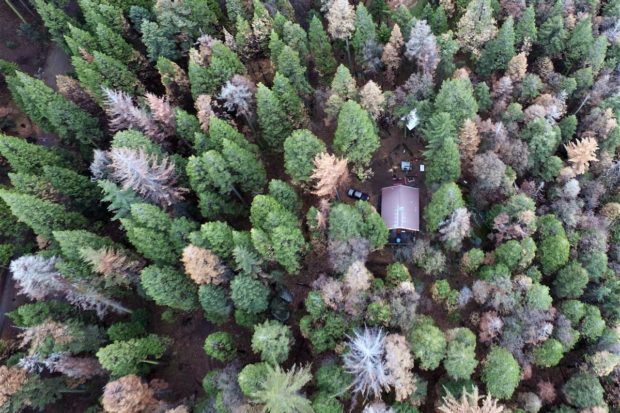
By Tom Frantz
We know that most of our air pollution comes from industrial operations and mobile sources. But this pollution does not just stay in the air that we breathe on the Valley floor. Summer heat waves and prevailing southeasterly winds carry this pollution high into the mountains to our east.
A 1977 study, “Air Pollution Damage to the Forests of the Sierra Nevada Mountains of California,” by Wayne Williams, documented ozone damage to trees in the Sequoia National Forest and Kings Canyon National Park. The species most susceptible was the pines, but damage was found in black oak, white fir and the giant sequoias as well. Previous observations of this damage to our forests go back to 1963. Damage was noted between 3,000 and 8,500 feet on western facing slopes.
Ozone damage to trees is indicated by a chlorotic mottle on the needles. Damage has been recorded at ozone levels as low as 30 parts per billion. Our health standard today is set at 70 parts per billion.
There is no doubt that the recent death of millions of trees in the Sierras was not due to drought alone. For decades, ozone pollution has caused premature death to both forest and urban trees, just as it has done to humans. The recent drought conditions simply exacerbated what was already a serious ecological problem.
The San Bernardino and San Jacinto mountains of the Los Angeles region experienced a massive die-off of trees many years ago due to high ozone levels. This forest degradation is notable today in the resort areas of Idyllwild and Crestline where wealthy people think they can go to escape the smog in the basin below. Crestline, for many years, has seen the worst ozone levels in the entire LA region. Only Arvin, in Kern County, had more ozone violations in the past. Arvin is now much cleaner since the monitor there was illegally and secretly removed in 2010.
In the San Joaquin Valley, there is an ozone monitor in the town of Three Rivers, at the entrance to Kings Canyon National Park, around 1,700 feet. Besides trees, there are a lot of communities at this elevation throughout the east side of the valley. This monitor, called Ash Mountain, has recorded more cumulative ozone standard violations than any other Valley site since the Arvin monitor removal. A second monitor in the park, at 6,300 feet, regularly records ozone levels as high as 100 parts per billion.
The San Joaquin Valley Air Pollution Control District, a so-called health agency, is not only responsible for ozone damage to people’s lungs but for this ozone damage to our forests. But they will not accept the responsibility. When they document the number of recent ozone violations at their monthly meetings, they do not count those occurring at monitors above the Valley floor. Their excuse is that few people live there.
Steve Worthley, of the Air Board, has claimed that lack of logging in the forests or “forest management,” as he defines it, has caused the death of millions of trees through “overcrowding.” He explained at an Air Board meeting that we can reduce the smoke from forest fires and get more water from the Sierras, if we would only remove more of the trees. These are ridiculous claims originating from the logging industry, which Worthley has represented in the past as an attorney.
The importance of a healthy forest cannot be underestimated. The Sierra forests provide us with most of our annual water supply. Forests attract rain and snow storms. The trees slow down the runoff preventing flooding. The roots and soil allow percolation and filtering of water into our aquifers. The forests contain beneficial insects such as ladybugs that benefit us on the Valley floor. The biodiversity of the forest provides mushrooms, medicine and thousands of species of wildlife that help make the earth a healthy environment for humans. Our forests relieve stress and provide recreation for millions. There is no doubt the excessive logging and building of roads desired by special interests would impact our ability to farm and our quality of life on the Valley floor.
It is important in the struggle for clean air that we remember it is not only the Valley floor that suffers from air pollution. Our beautiful and beneficial Sierra forests and national parks are being devastated by industrial air pollution originating from human activity below. Our political leaders unfortunately represent the special interests that do not want us to think about that. Their current desire to shrink the Giant Sequoia National Monument to increase logging is another symptom of their shortsighted thinking.
*****
Longtime clean air advocate Tom Frantz is a retired math teacher and Kern County almond farmer. A founding member of the Central Valley Air Quality Coalition (CVAQ), he serves on its steering committee and as president of the Association of Irritated Residents. The CVAQ is a partnership of more than 70 community, medical, public health, environmental and environmental justice organizations representing thousands of residents in the San Joaquin Valley unified in their commitment to improving the health of Californians. For more information, visit www. calcleanair.org.

[…] and the world need to rapidly reduce climate pollution to avoid the worst effects of climate change. We must also prepare for the continued acceleration […]